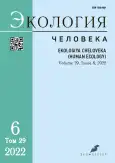Trends of the health and demographic indicators in the arctic regions of the Republic of Sakha (Yakutia) over 20 year (2000–2020)
- Authors: Burtseva T.E.1,2, Klimova T.M.1,2, Gogolev N.M.1, Sleptsova S.S.1, Afanaseva L.N.1, Sinelnikova E.V.3, Chasnyk V.G.3, Slobodchikova M.P.3
-
Affiliations:
- M.K. Ammosov North-Eastern Federal University
- Yakut Science Center for Complex Medical Problems
- Saint Petersburg State Pediatric Medical University
- Issue: Vol 29, No 6 (2022)
- Pages: 403-413
- Section: ORIGINAL STUDY ARTICLES
- URL: https://journals.rcsi.science/1728-0869/article/view/106043
- DOI: https://doi.org/10.17816/humeco106043
- ID: 106043
Cite item
Full Text
Abstract
BACKGROUND: The implementation of the major federal projects in the Arctic region of the Russian Federation claims particular attention to the indicators of the quality of life and the state of population health in these regions. Health and demographic indicators can be one of the available tools for public health monitoring.
AIM: To analyze the main trends of the health and demographic processes in the arctic regions of the Republic of Sakha (Yakutia) over 20 year (2000–2020).
MATERIAL AND METHODS: The data of the Territorial Body of the Federal State Statistics Service in the Republic of Sakha (Yakutia), YARMIATS for 2000–2020 were analyzed. An approximate 95% confidence interval was calculated over 20 years (2000–2019), the average population growth rate was estimated by a chain method for time series (data for 2020 year are presented separately due to the deformation of the pattern of demographic indicators due to the epidemic SARS-CoV-2). A linear regression analysis of IBM SPSS Statistics 26 was performed to assess the birth and mortality rate trends.
RESULTS: From 2000–2020, the population of the Arctic region of the Republic of Sakha (Yakutia) decreased by 22% due to migration and high mortality rates. Deaths by external causes occupy approximately 20% of the structure of the all-cause mortality rate. Dynamically, the decrease in the number of infant mortalities was noticed due to the effective routing of pregnant women and improvement of the maternity service in the region.
CONCLUSION: The analysis of the medical and demographic indicators showed positive and negative trends in the Arctic regions’ public health of the Republic of Sakha (Yakutia). The system of the healthcare organization in the regions is to be improved. Also, these regions, which possess all the features of the healthcare systems with low-density population territories, can become a model for the regional and federal projects approbated in the field of Arctic medicine.
Keywords
Full Text
##article.viewOnOriginalSite##About the authors
Tatiana E. Burtseva
M.K. Ammosov North-Eastern Federal University; Yakut Science Center for Complex Medical Problems
Author for correspondence.
Email: bourtsevat@yandex.ru
ORCID iD: 0000-0002-5490-2072
SPIN-code: 5032-4405
Dr. Sci. (Med.), professor
Russian Federation, Yakutsk; YakutskTatiana M. Klimova
M.K. Ammosov North-Eastern Federal University; Yakut Science Center for Complex Medical Problems
Email: biomedykt@mail.ru
ORCID iD: 0000-0003-2746-0608
SPIN-code: 2635-0865
Russian Federation, Yakutsk; Yakutsk
Nikolay M. Gogolev
M.K. Ammosov North-Eastern Federal University
Email: gogrcemp@mail.ru
ORCID iD: 0000-0001-6696-7378
SPIN-code: 8663-8332
Russian Federation, Yakutsk
Snezhana S. Sleptsova
M.K. Ammosov North-Eastern Federal University
Email: sssleptsova@yandex.ru
ORCID iD: 0000-0002-0103-4750
SPIN-code: 2677-0163
Russian Federation, Yakutsk
Lena N. Afanaseva
M.K. Ammosov North-Eastern Federal University
Email: enanik2007@mail.ru
ORCID iD: 0000-0003-2592-5125
SPIN-code: 5567-4610
Russian Federation, Yakutsk
Elena V. Sinelnikova
Saint Petersburg State Pediatric Medical University
Email: sinelnikova_e@mail.ru
ORCID iD: 0000-0003-2213-3755
SPIN-code: 1948-5788
Russian Federation, Saint Petersburg
Vyacheslav G. Chasnyk
Saint Petersburg State Pediatric Medical University
Email: chasnyk@gmail.com
ORCID iD: 0000-0001-5776-1490
SPIN-code: 8175-0010
Russian Federation, Saint Petersburg
Maya P. Slobodchikova
Saint Petersburg State Pediatric Medical University
Email: limelight@mail.ru
ORCID iD: 0000-0002-8556-095X
SPIN-code: 3360-2299
Russian Federation, Saint Petersburg
References
- Zamyatina NYu, Pilyasov AN. the new theory of the Arctic and Northern development: multi-scale interdisciplinary synthesis. Arctic and North. 2018;(31):5–27. (In Russ). doi: 10.17238/issn2221-2698.2018.31.5
- Kirsanov KA. Nacional’naya ideya v Arkticheskom izmerenii. In: Civilizacionnye aspekty razvitiya Arkticheskikh regionov Rossii. Materialy II nauchno-prakticheskoj konferencii: sbornik statej. Moscow: Institut mirovyh civilizacij; 2021. P. 188–202. (In Russ).
- Mazur II. A new era in the development and development of the Arctic region. Vek globalizatsii [Age of globalization]. 2019;(3):89–95. (In Russ).
- Boyko ER. Physiological and biochemical foundations of human life in the North. Yekaterinburg: Ural’skoe otdelenie RAS, 2005. 192 p. (In Russ).
- Kaznacheev VP. Modern aspects of adaptation. Novosibirsk: Novosibirskoe otdelenie izdatel’stva «Nauka»; 1980. 192 p. (In Russ).
- Savvinov DD. Problemy prikladnoj ehkologii Severa: sostoyanie i perspektivy. In: Prikladnaya ehkologiya Severa: opyt provedeniya issledovanij, sovremennoe sostoyanie i perspektivy: materialy mezhdunarodnoj nauchno-prakticheskoj konferencii; 2003 March 20–21; Yakutsk. Yakutsk: Izdatel’stvo SO RAN; 2003. 290 p. (In Russ).
- Burtseva EI, Petrov AN. Ecological problems of the northern territories of Yakutia in the conditions of industrial development and global warming. Advances in current natural sciences. 2017;(5):83–88. (In Russ).
- Semenova NP. Ehkologo-gigienicheskaya kharakteristika sredy obitaniya i sostoyanie zdorov’ya naseleniya Respubliki Sakha (Yakutiya) [dissertation]. Irkutsk; 2015. (In Russ). Available from: https://search.rsl.ru/ru/record/01006646064
- Decree of the President of the Russian Federation of 02.05.2014 N 296 (ed. of 05.03.2020) “On the land territories of the Arctic zone of the Russian Federation” Available from: http://www.consultant.ru/document/cons_doc_LAW_162553 / (In Russ). [cited: 2022 March 20].
- sakha.gks.ru/ [Internet]. Results of the National population census of 2010. Volume 4: National composition and language proficiency, citizenship of the population of the Republic of Sakha (Yakutia). [cited 2022 March 3]. Available from: https://sakha.gks.ru/folder/39644 (In Russ).
- Regional Office of the Federal State Statistics Service for the Republic of Sakha (Yakutia). Available from: https://sakha.gks.ru/folder/32348. (In Russ). [cited: 2022 March 20].
- Smirnov AV. The population of the world Arctic: population dynamics and settlement centers. Arctic and North . 2020;(40):270–290. (In Russ). doi: 10.37482/issn2221-2698.2020.40.270
- Nikanov AN, Chashchin VP, Gudkov AB, et al. Medico-demographic indicators and formation of labor potential in the Russian Arctic (in the context of Murmansk region). Ekologiya cheloveka (Human Ecology). 2018;25(1):15–19. (In Russ). doi: 10.33396/1728-0869-2018-1-15-19
- Pavlenko VI, Petrov A, Kutsenko SYu, Detter GF. Indigenous peoples of the Russian Arctic (problems and prospects of development). Ekologiya cheloveka (Human Ecology). 2019;26(1):26–33. (In Russ). doi: 10.33396/1728-0869-2019-1-26-33
- Dudarev AA, Chupakhin VS, Odland JØ. Health and society in Chukotka: an overview. Int J Circumpolar Health. 2013;72:20469. doi: 10.3402/ijch.v72i0.20469
Supplementary files









